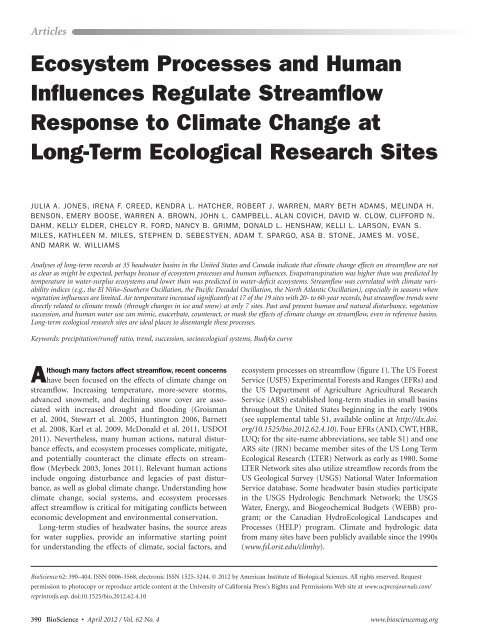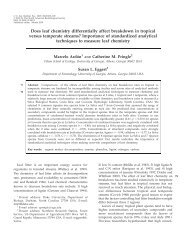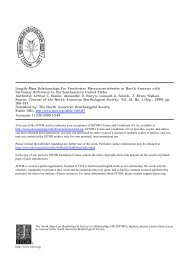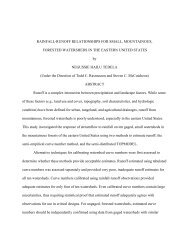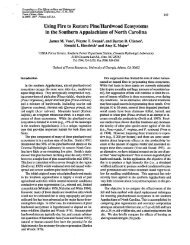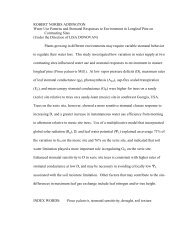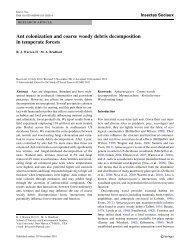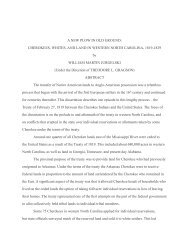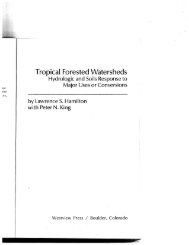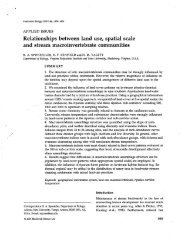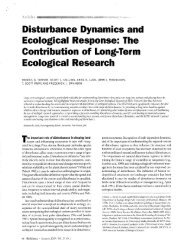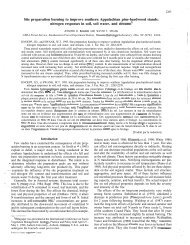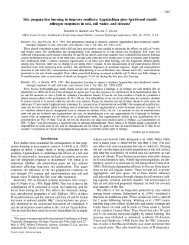biology join - Coweeta LTER - University of Georgia
biology join - Coweeta LTER - University of Georgia
biology join - Coweeta LTER - University of Georgia
Create successful ePaper yourself
Turn your PDF publications into a flip-book with our unique Google optimized e-Paper software.
Articles<br />
Ecosystem Processes and Human<br />
Influences Regulate Streamflow<br />
Response to Climate Change at<br />
Long-Term Ecological Research Sites<br />
Julia a. Jones, irena F. Creed, Kendra l. HatCHer, robert J. Warren, Mary betH adaMs, Melinda H.<br />
benson, eMery boose, Warren a. broWn, JoHn l. CaMpbell, alan CoviCH, david W. CloW, CliFFord n.<br />
daHM, Kelly elder, CHelCy r. Ford, nanCy b. GriMM, donald l. HensHaW, Kelli l. larson, evan s.<br />
Miles, KatHleen M. Miles, stepHen d. sebestyen, adaM t. sparGo, asa b. stone, JaMes M. vose,<br />
and MarK W. WilliaMs<br />
Analyses <strong>of</strong> long-term records at 35 headwater basins in the United States and Canada indicate that climate change effects on streamflow are not<br />
as clear as might be expected, perhaps because <strong>of</strong> ecosystem processes and human influences. Evapotranspiration was higher than was predicted by<br />
temperature in water-surplus ecosystems and lower than was predicted in water-deficit ecosystems. Streamflow was correlated with climate variability<br />
indices (e.g., the El Niño–Southern Oscillation, the Pacific Decadal Oscillation, the North Atlantic Oscillation), especially in seasons when<br />
vegetation influences are limited. Air temperature increased significantly at 17 <strong>of</strong> the 19 sites with 20- to 60-year records, but streamflow trends were<br />
directly related to climate trends (through changes in ice and snow) at only 7 sites. Past and present human and natural disturbance, vegetation<br />
succession, and human water use can mimic, exacerbate, counteract, or mask the effects <strong>of</strong> climate change on streamflow, even in reference basins.<br />
Long-term ecological research sites are ideal places to disentangle these processes.<br />
Keywords: precipitation/run<strong>of</strong>f ratio, trend, succession, socioecological systems, Budyko curve<br />
Although many factors affect streamflow, recent concerns<br />
have been focused on the effects <strong>of</strong> climate change on<br />
streamflow. Increasing temperature, more-severe storms,<br />
advanced snowmelt, and declining snow cover are associated<br />
with increased drought and flooding (Groisman<br />
et al. 2004, Stewart et al. 2005, Huntington 2006, Barnett<br />
et al. 2008, Karl et al. 2009, McDonald et al. 2011, USDOI<br />
2011). Nevertheless, many human actions, natural disturbance<br />
effects, and ecosystem processes complicate, mitigate,<br />
and potentially counteract the climate effects on streamflow<br />
(Meybeck 2003, Jones 2011). Relevant human actions<br />
include ongoing disturbance and legacies <strong>of</strong> past disturbance,<br />
as well as global climate change. Understanding how<br />
climate change, social systems, and ecosystem processes<br />
affect streamflow is critical for mitigating conflicts between<br />
economic development and environmental conservation.<br />
Long-term studies <strong>of</strong> headwater basins, the source areas<br />
for water supplies, provide an informative starting point<br />
for understanding the effects <strong>of</strong> climate, social factors, and<br />
ecosystem processes on streamflow (figure 1). The US Forest<br />
Service (USFS) Experimental Forests and Ranges (EFRs) and<br />
the US Department <strong>of</strong> Agriculture Agricultural Research<br />
Service (ARS) established long-term studies in small basins<br />
throughout the United States beginning in the early 1900s<br />
(see supplemental table S1, available online at http://dx.doi.<br />
org/10.1525/bio.2012.62.4.10). Four EFRs (AND, CWT, HBR,<br />
LUQ; for the site-name abbreviations, see table S1) and one<br />
ARS site (JRN) became member sites <strong>of</strong> the US Long Term<br />
Ecological Research (<strong>LTER</strong>) Network as early as 1980. Some<br />
<strong>LTER</strong> Network sites also utilize streamflow records from the<br />
US Geological Survey (USGS) National Water Information<br />
Service database. Some headwater basin studies participate<br />
in the USGS Hydrologic Benchmark Network; the USGS<br />
Water, Energy, and Biogeochemical Budgets (WEBB) program;<br />
or the Canadian HydroEcological Landscapes and<br />
Processes (HELP) program. Climate and hydrologic data<br />
from many sites have been publicly available since the 1990s<br />
(www.fsl.orst.edu/climhy).<br />
BioScience 62: 390–404. ISSN 0006-3568, electronic ISSN 1525-3244. © 2012 by American Institute <strong>of</strong> Biological Sciences. All rights reserved. Request<br />
permission to photocopy or reproduce article content at the <strong>University</strong> <strong>of</strong> California Press’s Rights and Permissions Web site at www.ucpressjournals.com/<br />
reprintinfo.asp. doi:10.1525/bio.2012.62.4.10<br />
390 BioScience • April 2012 / Vol. 62 No. 4 www.biosciencemag.org


